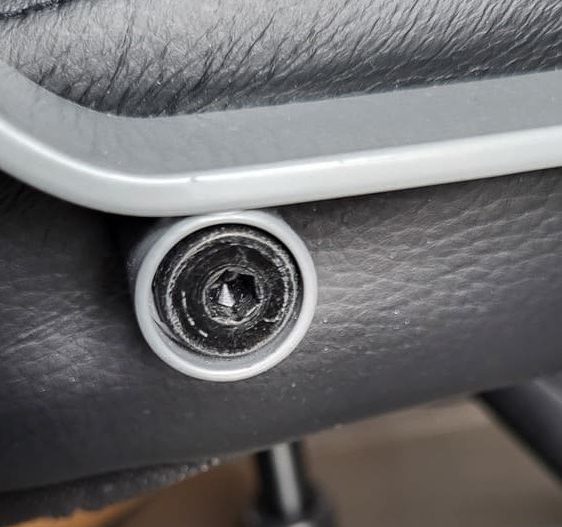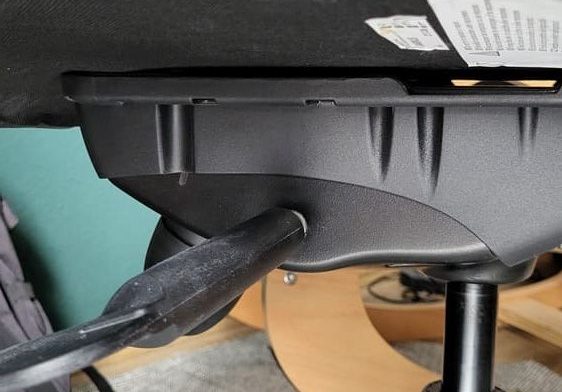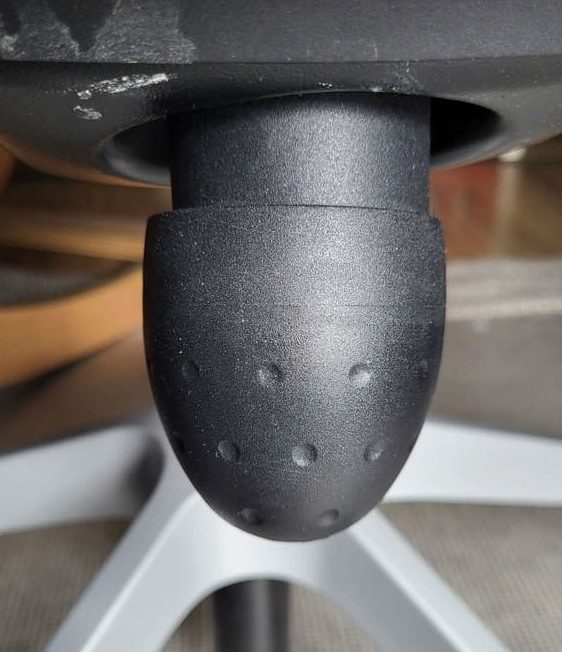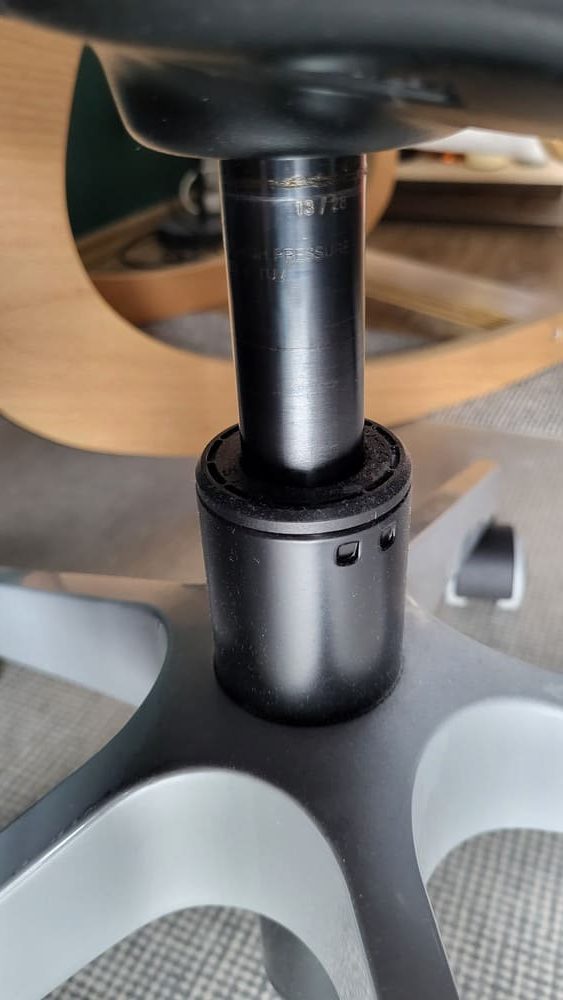*When you buy through links on our site, we may earn an affiliate commission at no additional cost to you.
Has your office chair started getting squeaky of late when you lean back on it or swivel to the sides? If yes, then you already know how annoying the squeaky noise can be to you and your co-workers in the room.
But this doesn’t mean it’s time to replace your computer chair. If you think about it, squeaking is made by movements. And if you can stop the movements, you can fix those unpleasant, ear-shattering sounds.
Checking all screws and nuts and ensuring they’re tight is one way to fix a squeaky office chair. Lubrication also eliminates movement/friction and stops the squeaky behavior.
Read our guide below for more tips on how to diagnose and fix a squeaky office chair.
Table of Contents
Why your chair is squeaky
Finding out what’s ailing your office chair can be a challenge if you don’t have a clue where to look.
As you already know, chairs are made up of many held together with bolts and nuts. Chairs are used for long hours every day and undergo a lot of tear and wear. Ultimately, they will become loose and start producing those creaky sounds.
This section will explain the most common causes of the squeaking in chairs and how to fix them.
Loose bolts and nuts
One of the most common reasons for a squeaky office chair is loose bolts and nuts. Almost every office chair you see, whether wooden or metallic, is held together by a handful of screws/nuts.
These can get loose over time, creating movements that lead to squeaks.
There are several reasons why your chair nuts get loose with continued use:

- During assembly, you may not have done the tightening of the nuts well. This is sure to make them get loose as you continue using them. This comes from the fact that loose bolts will get loose faster than the tight ones.
- Another reason your chair bolts may get loose is the constant stress the chair undergoes every day. As you collapse on your chair or weight shift while sitting in it, you’ll stress it with your body pressure. This will cause the nuts and bolts to undergo friction, turning to torque. If your bolts are already tight, the torque produced can’t tighten them any further, leaving it with one option; to push the bolts and make them loosen out.
- The bolts and nuts may also become loose due to temperature changes. Assuming your chair has metallic bolts and nuts, they’ll easily expand and contract due to room temperature.
Casters/wheels
If you look at the casters/wheels of your office chair closely, you’ll notice they have metal posts fixed on top of them. These posts tend to get worn out with continued use of the chair.

Also, the screws holding the wheels in place may become loose due to an overload placed on the chair. This will cause the wheel axle to create friction and ultimately squeak.
Sometimes faulty bearings on the wheels will also produce noises when using your chair.
Other parts of the office chair that can cause squeaking:
Besides the main areas above, below are additional parts of your chair you may want to look at for squeaking noises.
Weak joints
Office chairs feature joints such as cylinder-mechanism junction and the swivel-base junction. These joints may get weak over time and produce a squeaky noise.

How do they get weak? As you continue using your chair, these joints will be rubbing against each other, creating friction.
The friction will then cause the joints to loosen up—causing your chair to squeak every time the joints rub.
Look into the seat tension turn knob housing
Do you see that seat tension spring hiding at the bottom of your seat? Good. That can be a source of squeaking too.

This spring rests in the seat tension turn knob housing, so you’ll need to loosen the knob to fix the squeaking.
Hex shafts
If you’ve inspected every other part of your chair and still can’t get the culprit behind the squeaking noise, you may also want to examine the hex shafts.
A weak hold between the hex and shaft and the swing arm will produce creaking sounds.
The gas lift mechanism can also get noisy with time
When diagnosing a squeaking chair, another place to look at is the gas lift system. Pay attention to the gas lift piston, in particular.

It may have a damaged gasket on its shaft from the pneumatic cylinder. This could be the source of noise in your chair.
PRO TIP: You can have a friend sit on your chair to help you easily locate the area where the squeaking is coming from. Let your friend sit on the chair, swivel side to side, and even lead back as you listen keenly. This will make it much easier for you to fix the chair and eliminate the undesired noises.
How to fix squeaking office chairs?
With the above information in mind on the most common causes of squeaking in your office chair, it’s time to know how to fix them and put an end to the creaking.
Here is our step-by-step guide on how to fix a squeaking office chair:
Step 1: Inspect all the bolts, nuts, and screws
We said loose nuts and screws are one of the main culprits behind squeaking. With this in mind, it should be the first place to look at.
Turn over your seat and take a closer look at all its hardware by rotating them with your hand.

Use a screwdriver/wrench to tighten any loose screws and nuts. Try tightening the bolts that don’t appear loose as well, as it might be just a matter of time before they loosen up as well.
Step 2. Lubricate the nuts and screws
Apart from tightening them, you should also consider greasing the screws and bolts to help loosen them up.
Simply apply the lubricating oil on these hardware (we recommend using WD-40 for the best results) to loosen up the joints.
Be sure to apply the silicone spray directly on this hardware and then pat them dry with paper towels.

Alternatively, you can apply the lubricant on a soft cotton cloth and then rub it on the problem areas. This method will give you more control over where you want the oil to go.
Step 3. Take out all the screws and bolts
Does your seat continue squeaking, even after tightening all the bolts and lubricating them? If yes, consider taking them out.
This will enable you to treat them with light machine oil before putting them back in.
TIP: If you notice some of the screws are old and rusty, replace them with new ones to ensure they continue holding your seat together as they should.
Step 4. Lubricate the seat tension spring
If your chair only creaks when you lean back, you should focus on the seat tension spring.
You want to apply the lubricant to the seat tension springs inside the tension knob housing. To do this, loosen the knob and take it off. Spray the lubricating oil inside the housing.
Step 5. Work on the casters/wheels
If the problem comes from the casters and wheels, turn over the chair and spray its wheels with the grease.
Flip the chair back up and roll it over to help spread the silicone/lubricant around the wheels.
Step 6. Fixing other parts of the chair
Other parts that may become problematic, including the joints, hex shafts, and gas lift mechanism, can also be fixed by spraying them with the WD silicone spray.
How to fix creaky wooden chairs
What if you’re dealing with a wooden squeaky chair? In this case, the approach may differ from what we have discussed above.
Our tips below will help you fix a squeaky wooden chair:

- Turn your wooden chair upside-down or place it on another chair or a table. Locate the loose joint and use strong wood glue to fill the joint. Give the glue time to dry before you flip back the chair. Use a wet rag to wipe off any glue coming from the joint.
- If the wood making up the chair has shrunk and is causing the chair to become loose, consider taking the leg apart completely. Apply the wood swelling liquid to it to secure it again in your chair.
- If the screws and nuts are loose and not in good shape, consider replacing them to end the squeaking. And when getting replacement screws, make sure they’re thick and long enough to secure the wood.
Conclusion
Your office chair goes through a lot of stress every day, and it’s normal for it to turn squeaky and creaky as you stand, sit, swing to the sides, or lean back. Even the high-end chair models can get squeaky with time.
You don’t need to replace your squeaky office chair when it starts this behavior. You can fix it using the methods we have just discussed in this guide.
We have also provided you with a list of the most common causes of squeaky chairs. These will give you an idea of where to begin when diagnosing your chairs for the movements causing squeaking.
Aso read our guide about how to fix a sinking office chair if that’s a problem too.
Remember to use your gently every time, so you don’t loosen it with tame and make it go squeaky. Be gentle on it, and it will stay silent for long.



